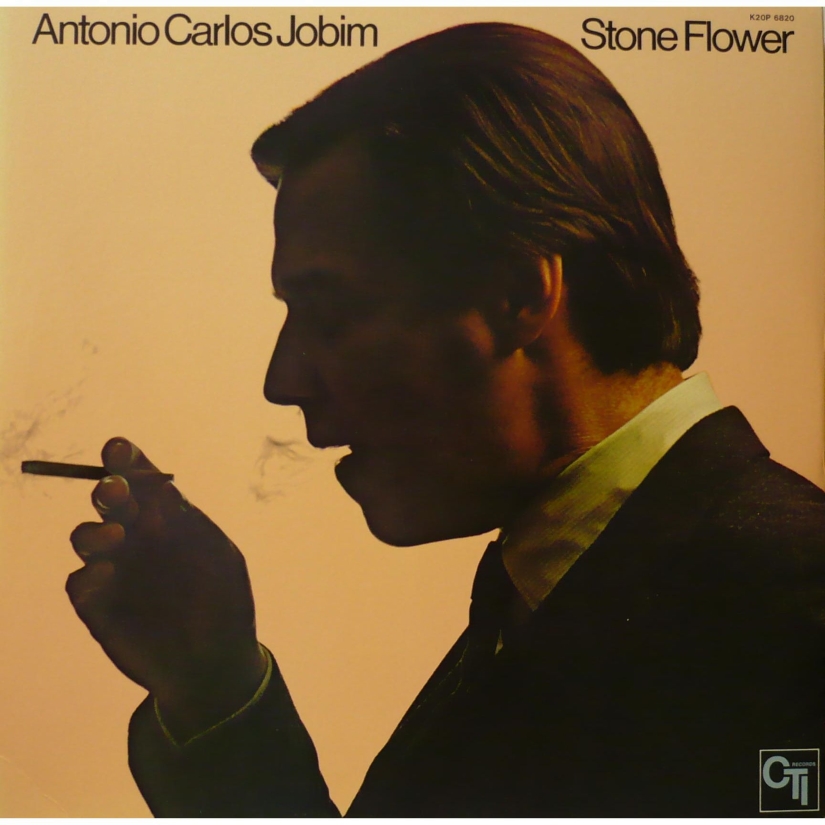
Antonio Carlos Jobim - Stone Flower
By George Moraitis
| Label: | CTI Records – CTI 6002 |
|---|---|
| Format: | Vinyl, LP, Album, Gatefold |
| Country: | US |
| Released: | 1970 |
| Genre: | Jazz |
| Style: | Bossa Nova |
Before you read on, I have a confession to make. Although I love jazz, I’m not really a bossa nova fan, or more accurately….I’m tired of it and generally bored by the genre. Every album by one of the Gilbertos, Stan Getz and even former Jobim has been so underwhelming to me that it would seem the genre just had no way of producing a masterpiece. So why am I of all people recommending this album?
Before Jobim brought his talents to the jazz world, he became a star in his native Brazil when he teamed up with the poet Vinícius De Moraes to compose the score for the play Orfeu da Conceição and some other works. Creed Taylor played a large part in bringing Jobim into the jazz world, after producing the Jazz Samba and Getz/Gilberto LPs, he signed Jobim first to Verve and then later to CTI where the pair recorded ‘Wave’, probably Jobim’s most well-known solo recording due to the popularity of the title track which quickly became a jazz standard.
By 1970 bossa nova had been exploited, commercialised and overdone. However…….recorded in 1970 at Rudy Van Gelder’s studio in New Jersey under the production auspices of Creed Taylor, the arrangement and conducting skills of Deodato, and the engineering expertise of Van Gelder himself, Jobim’s Stone Flower is quite simply one of his most quietly stunning works and in my opinion, one of the high points of the genre.
With a band that included both Jobim and Deodato on guitars (Jobim also plays piano and sings in a couple of spots), Ron Carter on bass, João Palma on drums, Airto Moreira and Everaldo Ferreira on percussion, Urbie Green on trombone, Joe Farrell on soprano saxophone, and Harry Lookofsky laying down a soulful violin solo on the title track, Jobim created his own version of Kind of Blue.
The set opens with the low, simmering “Tereza My Love,” with its hushed, elongated trombone lines and shifting acoustic guitars floating on the evening breeze. It begins intimate and ends with a closeness that is almost uncomfortably sensual, even for bossa nova. Jobim wrote this for his wife Tereza and Urbie Green showcases just how tender and seductive the trombone can be in the right hands. Children’s Games demonstrates Jobim’s dexterity and inventiveness on the keyboard with a singing, ringing piano sound achieved by whistling in exact time with his playing.
Among the highlights are the slippery piano melodies Jobim lets roll off his fingers against a backdrop of gauzy strings and syncopated rhythms in Brazil, which is the centrepiece of the album. A samba tune with a sprightly tempo brought to the fore by Jobim’s sandy, smoky vocal hovering ghost-like about the instrumental shimmer in the mix… this is a prime example of bossa nova at its best, with Jobim taking a turn on both vocals and electric piano, an instrument that adds a shimmering texture to the classic tune.
‘Andorinha’ with the relaxed heartbeat of Ron Carter’s bass and unhurried precision is like a slow-motion version of Brazil. It’s a nocturnal piece with a hint of unease, loneliness and lamenting. Urbie Green’s silky, urbane playing is so far removed from the brassy clichés associated with the trombone as to almost be another instrument altogether. ‘God and the Devil in the Land of the Sun’ moves towards freeform jazz as Joe Farrell on soprano sax creates sculptures in the air. This piece alone gives the album an edge and a hint of darkness that inoculates it against any danger of becoming easy listening. The genius here is to take a seductive melodic bossa vibe and infuse it with a sense of drama and slight bit of urgency. If you are so inclined, check out the 40th Anniversary Remaster, with an alternate take of Brazil as the tenth track (It’s worth it).
OK, so back to my initial question. Why am I recommending this album when I have admitted that the majority of bossa nova albums bored me? Because this music is nothing short of gorgeous.
It’s cool, elegant and sounds as nostalgic and elegiac as ever. It is so delicate yet complex in hue, so fragile yet meticulously constructed, so unassuming yet individual and personal that its beguiling. There are healing properties in this instrumental odyssey.
This is more than just a collection of clever pieces. Stone Flower is an album in the classical sense—distinct songs, uniting to form an overreaching concept or mood. Each song plays like a scene from a film, uniting to portray a greater story. Jobim’s mood narrative is one of slow-moving days set against quickly evolving emotions, fun with a sense of loneliness. A feeling swells up…. a need for escape… and once that has passed…reinvention.
Track listing
1. Tereza My Love
2. Children’s Games
3. Choro
4. Brazil
5. Stone Flower
6. Amparo
7. Andorinha
8. God And The Devil In The Land Of The Sun
9. Sabia
Credits
Recorded At – Van Gelder Studio, Englewood Cliffs, New Jersey
Manufactured By – Creed Taylor, Inc.
Lacquer Cut At – Van Gelder Studio, Englewood Cliffs, New Jersey
Bass – Ron Carter
Design [Album] – Tony Lane (2)
Drums – João Palma
Engineer [Recording] – Rudy Van Gelder
Flute [Solo] – Hubert Laws (tracks: B2)
Guitar, Arranged By, Conductor – Eumir Deodato
Percussion – Airto Moreira, Everaldo Ferreira
Photography By – Pete Turner (4)
Piano, Electric Piano, Violin, Vocals, Guitar – Antonio Carlos Jobim
Producer – Creed Taylor
Saxophone [Soprano Solo] – Joe Farrell (tracks: B4)
Trombone [Solos] – Urbie Green
Violin [Solo] – Harry Lookofsky (tracks: B1)
